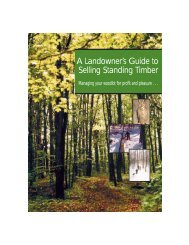Tips on winching and using a snatch block - Ontario woodlot.com
Tips on winching and using a snatch block - Ontario woodlot.com
Tips on winching and using a snatch block - Ontario woodlot.com
Create successful ePaper yourself
Turn your PDF publications into a flip-book with our unique Google optimized e-Paper software.
eplacing them. Use<br />
a good quality strap<br />
that is a minimum of 3<br />
inches wide, <strong>and</strong> keep<br />
in mind that the safe<br />
working load is greatly<br />
reduced when the<br />
strap is used choker<br />
style (i.e., anchoring<br />
the <strong>snatch</strong> <strong>block</strong> to a<br />
tree). For example, <strong>on</strong>e<br />
manufacturer lists the<br />
safe working load of their<br />
polyester sling at 12,800<br />
lbs. <strong>and</strong> that it is reduced<br />
to 4,800 lbs. when used<br />
choker style.<br />
• Another opti<strong>on</strong> to<br />
c<strong>on</strong>sider (instead of<br />
<strong>using</strong> a nyl<strong>on</strong> strap) is to<br />
attach the <strong>snatch</strong> <strong>block</strong><br />
to the tree <strong>using</strong> a Kevlar<br />
rope (i.e., a ½-inch Kevlar<br />
rope, tied in a figure 8<br />
loop or bowline <strong>on</strong> either<br />
end).<br />
• The <strong>snatch</strong> <strong>block</strong> should<br />
always be anchored to<br />
a healthy tree (i.e., no<br />
dead branches), have a<br />
minimum diameter of 8<br />
inches, <strong>and</strong> be located<br />
opposite the skid trail.<br />
• When positi<strong>on</strong>ing your<br />
tractor (winch) <strong>and</strong><br />
determining your line of<br />
pull, make sure you do<br />
not double back! If you<br />
do, you will be doubling<br />
the stress <strong>on</strong> everything<br />
(i.e., <strong>snatch</strong> <strong>block</strong>,<br />
anchor strap, <strong>and</strong> cable)<br />
except the winch.<br />
• Winching at an angle<br />
greater then 30 degrees<br />
(to your line of pull) may<br />
cause your machine<br />
to tip. Either repositi<strong>on</strong><br />
your equipment or use a<br />
<strong>snatch</strong> <strong>block</strong> to prevent<br />
this unsafe operating<br />
c<strong>on</strong>diti<strong>on</strong>.<br />
• If you need to implement<br />
a minor change in<br />
directi<strong>on</strong> to the pull, just<br />
choke the keyhole slider<br />
to a stump <strong>using</strong> a chain.<br />
Do not try to change the<br />
directi<strong>on</strong> more than 15<br />
degrees. This method is<br />
for occasi<strong>on</strong>al use. (If it is<br />
d<strong>on</strong>e too often, the cable<br />
will be cut by the slider<br />
yoke).<br />
If you notice that you<br />
are going through a lot<br />
of gloves while h<strong>and</strong>ling<br />
the winch cable, the<br />
cable is beginning to<br />
fray. Remember that it is<br />
<strong>on</strong>ly the last 10-20 feet<br />
that take the majority of<br />
the abuse. To solve this<br />
problem, simply reverse<br />
the cable as follows:<br />
• Pay attenti<strong>on</strong> to the<br />
directi<strong>on</strong> the cable<br />
<strong>com</strong>es off of the drum<br />
because it must be<br />
C<strong>on</strong>tinued next page ...<br />
Figure 2. The following photographs <strong>and</strong> text<br />
provides details <strong>on</strong> how to c<strong>on</strong>struct a selfreleasing<br />
<strong>snatch</strong> <strong>block</strong>, something that can be<br />
made up at a local machine shop.<br />
1. Sheave – machined 5 inch<br />
(outside diameter) by 4½<br />
inch (inside diameter) sheave<br />
with a 1½ bored centre (to<br />
ac<strong>com</strong>modate the brass<br />
bushing insert). The ½-inch<br />
groove ac<strong>com</strong>modates 3 /8 -inch<br />
cable.<br />
2. Brass bushing – machined 1½- inch (diameter)<br />
brass bushing with a 1-inch bored centre (to<br />
ac<strong>com</strong>modate the 1- inch steel stock).<br />
3. Steel stock – 1 inch (diameter) by 2 inches (length)<br />
steel stock with a 3 /8 - inch bored centre with <strong>on</strong>e<br />
end threaded (½ inch) to ac<strong>com</strong>modate a 3 /8 -inch<br />
bolt. The round steel stock is inserted into the steel<br />
plate <strong>and</strong> welded into place.<br />
4. Steel plate (body) – ½ inch (thick) by ¾ inch (width)<br />
by 6 inches (length) with a 1-inch bored centre (to<br />
ac<strong>com</strong>modate the machined steel stock).<br />
5. Steel rod (h<strong>and</strong>le) – ½ inch (diameter) by 5 inches<br />
(length) by 4 ¾ inches (width). The steel rod is<br />
heated <strong>and</strong> formed into a “U” shape <strong>and</strong> welded to<br />
the steel plate.<br />
6. Bolt <strong>and</strong> washer – 3 /8 -inch bolt (diameter) by 2 ¾<br />
(length) with a 2-inch washer.<br />
OWA - Dedicated to the Wise Use of <strong>Ontario</strong>’s Private Forests 25

















